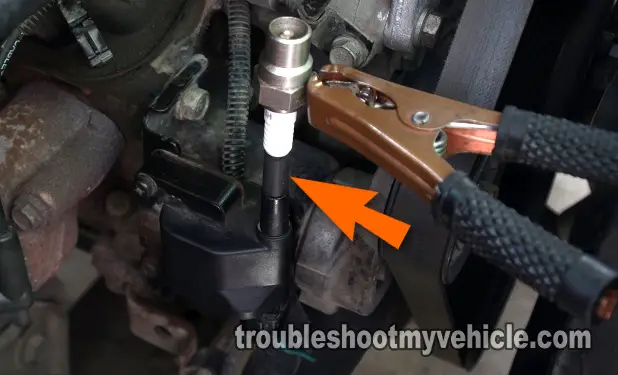IGNITION COIL TEST 2: Testing For Spark Directly On The Coil Tower

So far, in troubleshooting your Dodge's no-spark no-start condition, you have confirmed that the ignition coil's high tension wire is not delivering spark to the distributor cap.
In this test step, you're gonna' test for spark directly on the ignition coil to find out if the spark plug wire (high tension wire) that connects the ignition coil to the distributor cap is bad or not.
Depending on your spark test result, you'll know if the high tension cable is bad and not letting spark thru' to the distributor cap (this happens quite a bit) or will let you know that you need to continue to the next test.
Alright, this is what you'll need to do:
- 1
Disconnect the high tension wire from the ignition coil.
- 2
Connect the HEI spark tester to the ignition coil's tower using a small piece of vacuum hose.
IMPORTANT: Using a small piece of vacuum hose will help you keep the spark tester on the ignition coil tower. See how I've done it in the photo above. - 3
Connect the spark tester using a battery jump start cable directly on the battery negative (-) terminal.
- 4
When ready, have your helper crank the engine as you eyeball the HEI spark tester.
- 5
You'll see one of two results: spark or no spark.
OK, let's take a look at what your test results mean:
CASE 1: You got spark. This is the correct test result.
You can conclude that the high tension wire (that connects the ignition coil to the distributor cap) is FRIED and is the cause of the engine's no-start condition if you have:
- Confirmed that the high tension wire does not spark (TEST 1).
- Confirmed in this test section that the ignition coil tower does spark.
Replace all of the spark plug wires as a set.
If you'd like to save a few bucks on the spark plug wire set, take a look at the section: Where To Buy The Ignition Coil And Save.
CASE 2: You got NO spark. This spark test result eliminates the high tension wire and means you're getting closer to the actual cause of the ignition coil's no spark condition.
The next steps are to verify that the powertrain Control Module (fuel injection computer) is feeding power and activating the ignition coil. For this test, go to: IGNITION COIL TEST 3: Making Sure The Ignition Coil Is Getting 12 Volts.
IGNITION COIL TEST 3: Making Sure The Ignition Coil Is Getting 12 Volts

So far, in troubleshooting the ignition coil, you have:
1. Made sure that there's no spark from the ignition coil wire (TEST 1).
2. You have tested for spark directly on the ignition coil and go a no spark test result.
The next couple of tests are to see if the ignition coil is getting fed with power (12 Volts) and the switching signal.
In this test step, you'll check for these 12 Volts either using a multimeter or a 12 V DC test light.
Alright, this is what you'll need to do:
- 1
Place your multimeter still in Volts DC mode.
- 2
Disconnect the ignition coil from its electrical connector.
- 3
Probe the front of the terminal that connects to the wire labeled with the number 2 (in the photo above) with the red multimeter test lead.
NOTE: Gently probe the front of the female terminal with the multimeter test lead to prevent damaging it. - 4
Connect the black multimeter test lead to the battery's negative (-) post.
- 5
Have your helper crank the engine.
NOTE: Cranking the engine is important, because the ignition coil will only get power when the engine is either cranking or running. - 6
Your multimeter should register 10 to 12 Volts DC.
Let's take a look at what your results mean:
CASE 1: The multimeter registered 10 to 12 Volts. This is the correct result and tells you that the ignition coil is getting battery power (12 Volts).
The next step is to check that the ignition coil is getting a switching signal from the powertrain Control Module (PCM). Go to: IGNITION COIL TEST 4: Checking For The Presence Of The Activation Signal.
CASE 2: The multimeter DID NOT register 10 to 12 Volts. Double check your multimeter connections and repeat the test. If your multimeter results still do not indicate 12 Volts, then ignition coil is not fried and not the cause of the 'no-spark no-start' problem, since without power, it won't work.
The two most likely causes for this missing voltage are: 1.) The Auto Shut Down (ASD) relay is bad or 2.) the crankshaft position (CKP) sensor is bad.
Although it's beyond the scope of this article to find the cause of these missing 12 Volts, resolving this issue will solve the no-spark no-start issue.
